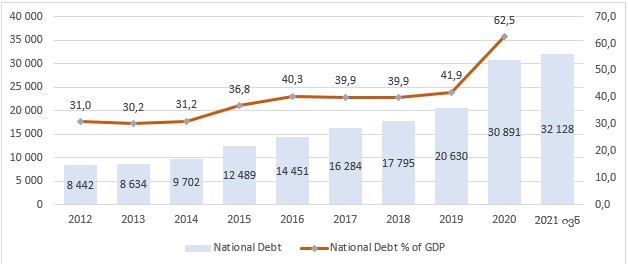Lasha Khutsishvili: “The growth of the national debt, to a similar extent, happened almost everywhere if you take a look at other countries.”
Verdict: FactCheck concludes that Lasha Khutsishvili’s statement is MOSTLY FALSE.
Resume:
Georgia has not been an exception where the national debt increased because of the pandemic. At the same time, of interest is the extent to which the Minister’s statement is true and whether or not the national debt in other countries grew in a similar proportion.
As compared to 2019, Georgia’s government debt increased by 50% in 2020 from 40.4% of the GDP to 60.6%. With this growth, Georgia is ranked 10th among the world’s 190 countries. Georgia’s government debt increased 2.5 times as compared to the global average debt growth rate. Georgia’s government debt increased the most among the immediate neighbor countries and was twice as high as compared to that of the neighbor countries.
Analysis
The Minister of Finance of Georgia, Lasha Khutsishvili, speaking about the debt before the Parliament of Georgia, stated: “The growth of the public debt, to a similar extent, happened almost everywhere if you take a look at other countries.”
Georgia’s massive debt growth is one of the most acute and pressing issues of 2020-2021 which warrants particular scrutiny from the public. In particular, the nominal debt figure increased by GEL 11.5 billion as of May 2021 as compared to 2019 whilst the debt to the GDP ratio increased by 20.6 percentage points in 2020 as compared to 2019.
Graph 1: National Debt Dynamic in 2012-2021 (May)

Source: Ministry of Finance of Georgia, National Statistics Office of Georgia, author’s calculations
Given the pandemic-related circumstances, Georgia certainly has not been an exception in terms of a sharp growth of debt figures. One of the standard crisis response mechanisms routinely used of late by the absolute majority of the world’s countries is to stimulate the economy with budget resources and counter-balance surging social problems. The fiscal component of the government response affects the country’s budget in two areas – on the one hand, the expenses for social assistance and stimulating the economy grow and, on the other hand, economic activity contracts and, therefore, the budget receives less tax incomes as compared to the planned amount. Given these circumstances, a sharp growth of the debt was brought to the agenda. At the same time, of interest is the extent to which the Minister’s statement is true and whether or not the national debt in other countries truly grew in a similar proportion.
The International Monetary Fund’s database which was last updated in April 2021 is a convenient source for analysis. As there are no precise debt figures from all countries, statistics from 2019 include forecasted figures. However, given the publication period, the figures are mostly in line with the reality. Percentage changes in the debt to the GDP ratio are relevant although the percentage growth of the nominal debt number will also be close to the aforementioned figure. As compared to 2019, Georgia’s government debt increased by 50% in 2020 from 40.4% of the GDP to 60.6%. With this growth, Georgia is ranked 10th among the world’s 190 countries. Of the 190 countries, the average government debt figure was 18.6% but the debt to the GDP ratio decreased in the cases of 20 countries. Of these countries whose debt increased, the average government debt growth was 21.6%. Therefore, Georgia’s government debt increased 2.5 times as compared to the global average debt growth rate.
Estonia had the highest growth in its debt to the GDP ratio at 119%. However, such a massive growth was stipulated by the fact that Estonia’s debt to the GDP ratio was small and constituted only 8.4% of the GDP which increased to 18.5%. Of the countries where the government debt to the GDP ratio fluctuated between 30% and 50%, Georgia is still a “leader” in borrowing and keeps the fourth position within the 65 countries. Georgia’s immediate neighbor countries have also had a large growth of debt. Table 1 shows the government debt to the GDP ratio in Georgia and in the neighbor countries.
Table 1: Estimated Figures of Government Debt to GDP Ratio in 2019-2020*

Source: International Monetary Fund








